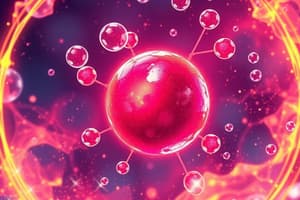Podcast
Questions and Answers
What types of ions are ionic compounds made of?
What types of ions are ionic compounds made of?
- Metal ions only
- Cations and anions (correct)
- Only cations
- Only anions
What defines a molecular compound?
What defines a molecular compound?
A molecular compound consists of nonmetal atoms bonded together by shared electrons.
What ion does Lithium (Li) form?
What ion does Lithium (Li) form?
Lithium ion
What is the formula for the cadmium ion?
What is the formula for the cadmium ion?
What is the name of the ion formed from Silver (Ag)?
What is the name of the ion formed from Silver (Ag)?
What is the charge of the iron ion that indicates it is iron (II)?
What is the charge of the iron ion that indicates it is iron (II)?
What is the name of the ion formed from Aluminum (Al)?
What is the name of the ion formed from Aluminum (Al)?
What is the name of the ion formed from Nitrogen (N)?
What is the name of the ion formed from Nitrogen (N)?
The ion formed from Oxygen (O) is called the ______ ion.
The ion formed from Oxygen (O) is called the ______ ion.
Which of the following metals can form more than one ion?
Which of the following metals can form more than one ion?
Match the following elements with their respective ion names:
Match the following elements with their respective ion names:
What suffix is used in naming anions?
What suffix is used in naming anions?
Study Notes
Types of Compounds
- Ionic compounds are formed from the electrostatic attraction between positive ions (cations) and negative ions (anions)
- Cations are positively charged ions, typically formed by metals
- Anions are negatively charged ions, typically formed by nonmetals
- Ionic compounds often consist of a combination of metals and nonmetals
- Molecular compounds are formed by the sharing of electrons between nonmetal atoms (covalent bonding)
- Molecular compounds can be acids, which release hydrogen ions (+H) in water
Naming Monatomic Cations
- Groups IA-IIIA, Silver (Ag), Zinc (Zn), and Cadmium (Cd): These elements form only one type of ion each.
- Group IA elements form +1 ions (e.g., Li+, Na+, K+, Rb+, Cs+)
- Group IIA elements form +2 ions (e.g., Be+2, Mg+2, Ca+2, Sr+2, Ba+2)
- Group IIIA elements form +3 ions (e.g., Al+3)
- Silver ion = Ag+
- Zinc ion = Zn+2
- Cadmium ion = Cd+2
- Naming: element name + ion (e.g., sodium ion, strontium ion, zinc ion)
- Transition Metals and Other Metals with Multiple Ions: The Stock system is used to name these metals.
- Transition metals often form more than one ion (e.g., Iron forms Fe+2 and Fe+3)
- Naming: element name (charge in Roman numerals) + ion (e.g., iron (II) ion, lead (IV) ion, copper (I) ion)
Naming Monatomic Anions
- Nonmetals gain valence electrons to become negatively charged ions (anions)
- Naming: element stem name + "ide" + ion (e.g., oxide ion, nitride ion)
Studying That Suits You
Use AI to generate personalized quizzes and flashcards to suit your learning preferences.
Related Documents
Description
Explore the differences between ionic and molecular compounds, including their formation and characteristics. Test your knowledge on naming monatomic cations from various groups. This quiz covers important concepts in chemistry related to ionic bonding and nomenclature.




